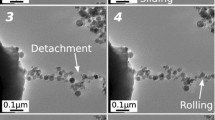Abstract
In this paper, a 2D atomic-scale finite-element model of tension in nanoscale thin film is developed in which Morse’s potential energy function is used to model the interactive forces between atoms. The model is fed into the finite-element package LS-DYNA and both a single integration point and an explicit solution method are used for solving the tension process rapidly to investigate the size effect of different film thicknesses and the effect of different atomic vacancy ratios on nanoscale thin film under tension. The results show that since the applied displacement is exerted at both ends for different thickness of a perfect crystal, a neutral line is formed at the middle of the material. The material slides along the easiest slip direction to cause a “necking” feature on both sides. The stress initially increases with the gradual increase of strain and thicker film shows a larger tensile stress. After the film experiences the peak stress, the stress then decreases with the gradual increase of strain. While the applied displacement is applied at both ends for different vacancies, a neutral line is formed at the middle of material, but this is not apparent due to the random scattered vacancies. The material slides along the easiest slip direction from left to right, and the stress concentration areas near the constrained ends form “necking” features. Stresses are not zero at zero strain. Tension tests for different vacancy ratios show different maximum stresses. Film with a larger vacancy ratio shows a lower stress at the same strain. As the vacancy ratio of the film under tension increases, the strength and elastic modulus reduces.
Similar content being viewed by others
References
Madou MJ (1997) Fundamentals of microfabrication. CRC Press, Boca Raton
Milstein F (1973) Applicability of exponentially attractive and repulsive interatomic potential function in description of cubic crystals. J Appl Phys 44(9):3825–3832
Gainutdinov II, Pavlukhin YT, Boldyrev VV (1996) Computer simulation of the plastic deformation of 2D Lennard-Jones crystals. J. Alloy Compd 234(1):101–105
Zhang L, Tanaka H (1997) Towards a deeper understanding of wear and friction on the atomic scale: a molecular dynamics analysis. Wear 221(5):44–53
Isono Y, Tanaka T (1997) Three-dimensional molecular dynamics simulation of atomic scale precision processing using a pin tool. JSME Int J Ser A: Mech Mater Eng 40:211–218
Michalske TA, Houston JE (1998) Dislocation nucleation at nanoscale mechanical contacts. Acta Mater 46(2):391–396
Tang QH, Wang TC (1998) Deformation twining and its effect on crack extension. Acta Mater 46(15):5313–5321
Isono Y, Tanaka T (1999) Molecular dynamics simulation of atomic scale indentation and cutting process with atomic force microscope. JSME Int J Ser A: Mech Mater Eng 42(2):158–166
Komanduri R, Chandrasekaran N, Raff LM (2000) Molecular dynamics simulation of atomic-scale friction. Phys Rev B 61(20):14007–14019
Fang TH, Weng CI (2000) Three-dimension molecular dynamics analysis of processing using a pin tool on the atomic scale. Nanotechnology 11:148–153
Inamura T, Suzuki H, Takezawa N (1991) Cutting experiments in a computer using atomic models of a copper crystal and a diamond tool. Int J Jpn Soc Precis Eng 25(4):259–266
Inamura T, Takezawa N (1992) Atomic-scale cutting in a computer using crystal models of copper and diamond. Ann CIRP 41(1):121–124
Inamura T, Takezawa N, Kumaki Y (1993) Mechanics and energy dissipation in nanoscale cutting. Ann CIRP 42(1):79–82
Jeng YR, Tan CM (2002) Computer simulation of tension experiments of a thin film using an atomic model. Phys Rev B 65:174107(1–7)
Holian BL, Voter AF, Wanger NJ (1991) Effects of pairwise versus many-body forces on high-stress plastic deformation. Phys Rev A 43(6):2655–2661
LS-DYNA Theory manual (2000) Livermore Software Technology, Livermore, CA
Jean Luc LACOME (2000) Smooth particle hydrodynamics (SPH): a new feature in LS-DYNA. 6th international LS-DYNA user’s conference simulation 7.29–7.33
Aya T, Nakayama T (1997) Influence of environmental temperature on yield stress of polymers. JSME Int J Ser A 40(3):343–348
Heino P, Hakkinen H, Kaski K (1998) Molecular-dynamics study of copper with defects under strain. Phys Rev B 58(2):641–652
Author information
Authors and Affiliations
Corresponding author
Rights and permissions
About this article
Cite this article
Chiu, JT., Lin, YY., Shen, CL. et al. Atomic-scale finite-element model of tension in nanoscale thin film. Int J Adv Manuf Technol 37, 76–82 (2008). https://doi.org/10.1007/s00170-007-0959-2
Received:
Accepted:
Published:
Issue Date:
DOI: https://doi.org/10.1007/s00170-007-0959-2




